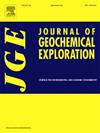Mississippi Valley-type mineralization in the Jurassic Smackover Formation, Gulf Coast Basin, USA: Controls on the origin of Zn-Pb-Ag systems in deep sedimentary basins
IF 3.4
2区 地球科学
Q1 GEOCHEMISTRY & GEOPHYSICS
引用次数: 0
Abstract
The northern margin of the central Gulf Coast Basin provides an opportunity to examine Mississippi Valley-type (MVT) Zn-Pb-Ag sulfide mineralization at depths of 2.5+ km and under interpreted formative conditions. This geologically young province is a significant petroleum producer, including from the Upper Jurassic Smackover Formation. The Smackover in this area contains circa 100 °C Na-Ca-Cl brines with elevated H2S, Br, and Li concentrations. The Smackover intercepted in the No. 1 Teague well contains Zn-Pb-Ag sulfides throughout the entire cored interval from 2549 to 2586 m with the highest concentrations in ooid grainstones in the upper 10 m. Stylolites are locally dilated and contain euhedral sulfide crystals, indicating that at least some sulfide mineralization post-dates maximum burial and compaction. Ag content of the high Zn-Pb zones generally is low (<1 to 10 ppm), but a 1.5-m acanthite-bearing interval averages 545 ppm.
Fluid inclusions (FI) were studied in late-stage calcite and sphalerite in the No. 1 Teague core. Homogenization temperatures (Th) for aqueous fluid inclusions in sphalerite range between 93 and 113 °C, whereas Th for FI in calcite are between 72 and 126 °C. Oil inclusions in late-stage calcite homogenize between 82° and 105 °C. Final ice melting temperatures of FI in sphalerite range from -24.9° and -26.5 °C, corresponding to salinities of 25.5 to 26.5 wt% NaCl equivalent. Final melting temperature of FI in calcite range from -26.0 to -23.2 °C for water ice and -5.8 to -7.8 °C for hydrohalite, corresponding to NaCl and CaCl2 of concentrations ranging from 15.2 to 20.3 wt% NaCl and 5.6 to 11.7 wt% CaCl2, respectively. The first melting temperatures for FI ranging ∼ -50 to -60 °C are comparable to the eutectic (-52 °C) for the NaCl-CaCl2-H2O system, and fluid salinities ∼26 wt% TDS are compatible with current Smackover formation waters. δ34SCDT of Smackover sulfides ranges from 8.9 to 16.6 ‰, and Smackover H2S has a similar δ34SCDT range (18 ± 2 ‰) as Late Jurassic seawater sulfate, suggesting that thermochemical reduction of reservoir sulfate was the source of H2S for sulfide precipitation. A complex history of local crustal Pb evolution is indicated by the radiogenic Pb isotope characteristics of galena. These relationships support the introduction of a metal-bearing brine into a H2S-rich Smackover reservoir resulted in local Zn-Pb-Ag sulfide precipitation. Burial history plots for the Smackover in southern Arkansas indicate that maximum burial occurred during the early Paleogene. Smackover MVT sulfides not only occur at depths >2.5 km, but sulfide minerals within dilated stylolites indicate that mineralization also took place at these depths. Smackover Zn-Pb-Ag sulfide concentrations represent one of the youngest and deepest known examples of MVT mineralization.
美国墨西哥湾沿岸盆地侏罗系Smackover组密西西比河谷型成矿作用:对深沉积盆地中锌-铅-银体系成因的控制
墨西哥湾中央海岸盆地的北缘提供了一个机会来研究密西西比河谷型(MVT)的锌-铅-银硫化物矿化,深度超过2.5公里,并在解释的形成条件下。这个地质年轻的省份是一个重要的石油生产国,包括上侏罗统Smackover组。该地区的Smackover含有约100°C的Na-Ca-Cl盐水,H2S, Br和Li浓度升高。Teague 1井拦截的Smackover在2549 ~ 2586 m的整个取心层段中都含有Zn-Pb-Ag硫化物,在10m以上的鲕粒岩中含量最高。茎柱岩局部扩张,含自面体硫化物晶体,表明在最大埋藏和压实期之后至少有硫化物矿化。高铅锌带的Ag含量一般较低(约1 ~ 10 ppm),而1.5 m含棘石层段的Ag含量平均为545 ppm。对蒂格1号岩心晚期方解石和闪锌矿进行了流体包裹体(FI)研究。闪锌矿中含水流体包裹体的均一温度(Th)在93 ~ 113℃之间,方解石中FI的均一温度(Th)在72 ~ 126℃之间。方解石晚期的油包裹体在82°~ 105°C之间均质化。闪锌矿中FI的最终融冰温度范围为-24.9°~ -26.5°C,对应的盐度为25.5% ~ 26.5% NaCl当量。FI在方解石中的最终熔化温度,水冰为-26.0 ~ -23.2℃,水盐为-5.8 ~ -7.8℃,对应的NaCl和CaCl2浓度分别为15.2 ~ 20.3 wt% NaCl和5.6 ~ 11.7 wt% CaCl2。FI的首次熔融温度范围为-50至-60°C,与NaCl-CaCl2-H2O体系的共晶(-52°C)相当,流体盐度为- 26 wt% TDS,与目前的Smackover地层水兼容。Smackover硫化物的δ34SCDT范围为8.9 ~ 16.6‰,而Smackover H2S的δ34SCDT范围与晚侏罗世海水硫酸盐相似(18±2‰),表明储层硫酸盐的热化学还原作用是硫化物沉淀的H2S来源。方铅矿放射性成因铅同位素特征反映了局部地壳铅演化的复杂历史。这些关系支持在富含h2s的Smackover油藏中引入含金属盐水,导致局部Zn-Pb-Ag硫化物沉淀。阿肯色南部Smackover地区的埋藏史表明,最大埋藏期发生在古近纪早期。Smackover MVT硫化物不仅出现在深度2.5 km处,而且在膨胀的茎长岩中的硫化物矿物表明在这些深度也发生了矿化。Smackover Zn-Pb-Ag硫化物浓度代表了MVT矿化最年轻和最深的已知例子之一。
本文章由计算机程序翻译,如有差异,请以英文原文为准。
求助全文
约1分钟内获得全文
求助全文
来源期刊

Journal of Geochemical Exploration
地学-地球化学与地球物理
CiteScore
7.40
自引率
7.70%
发文量
148
审稿时长
8.1 months
期刊介绍:
Journal of Geochemical Exploration is mostly dedicated to publication of original studies in exploration and environmental geochemistry and related topics.
Contributions considered of prevalent interest for the journal include researches based on the application of innovative methods to:
define the genesis and the evolution of mineral deposits including transfer of elements in large-scale mineralized areas.
analyze complex systems at the boundaries between bio-geochemistry, metal transport and mineral accumulation.
evaluate effects of historical mining activities on the surface environment.
trace pollutant sources and define their fate and transport models in the near-surface and surface environments involving solid, fluid and aerial matrices.
assess and quantify natural and technogenic radioactivity in the environment.
determine geochemical anomalies and set baseline reference values using compositional data analysis, multivariate statistics and geo-spatial analysis.
assess the impacts of anthropogenic contamination on ecosystems and human health at local and regional scale to prioritize and classify risks through deterministic and stochastic approaches.
Papers dedicated to the presentation of newly developed methods in analytical geochemistry to be applied in the field or in laboratory are also within the topics of interest for the journal.
 求助内容:
求助内容: 应助结果提醒方式:
应助结果提醒方式:


